 ABSTRACT
ABSTRACT

 ABSTRACT
ABSTRACT
Using the World Wide Web (WWW) to access educational material for dermatology often entails downloading and viewing images. Image files are large (even in compressed form) and with the current technology there is a significant delay involved with their transfer, decompression, and display. The time required to display images is an important factor in how usable such material is. In order to streamline the image display process, we undertook a study of the efficiency of some of the current WWW browsing and viewing programs. From the results of the study, we make recommendations of specific viewing and browsing applications for the personal computer, Macintosh, and workstation platforms.
 INTRODUCTION
INTRODUCTION
When transferred to digital format for computer display, image files tend to be rather large, usually over 1 megabyte each in raw (uncompressed) form. Compressing these files and storing the information in smaller files, makes it more practical to store and transfer these images. For photographic images on the Internet, two types of image compression formats now dominate, Lempel-Ziv-Welsch (LZW) is used in Graphics Interchange Format (GIF) and Joint Photographics Experts Group (JPEG) algorithm is used in the JPEG File Interchange Format (JFIF). GIF is an 8-bit-per pixel format which reduces to 256 the number of colors which can be used. JPEG compression is usually a 24-bit-per-pixel format, allowing for display of 16 million colors. JPEG compression is said to be better than GIF compression for reproducing photographic images such as patient photographs.(1) JPEG compressed files are smaller than GIF files, but take longer to uncompress and display.
Images which are part of a WWW hypertext file (such as this) are displayed either by the browsing application or by an associated viewing program. Browsers are programs like National Super Computer Applications (NCSA) Mosaic or Netscape (Netscape Communications Corporation) that interact with servers to retrieve and display material.(2) Viewers are applications which may be used as helpers to decompress/translate and display images. Browsers usually have the ability to display some types of images, and rely on helper programs for other types. Images may be in-line (part of the page) or linked (displayed at the request of the user). For in-line images, Netscape will will display both JPEG and GIF while some forms of NCSA Mosaic only display GIF. For linked images, NCSA Mosaic passes all images to a helper application while Netscape has the option of also being a viewer. Viewing applications may have options other than simple viewing, including image setting adjustments, transforming formats, cutting and pasting, etc.(3)
The following is an evaluation of common viewing and browsing applications to determine the efficiency in the display of GIF and JPEG images.
 MATERIALS AND METHODS
MATERIALS AND METHODS
The images used in these tests were selected from a collection of 1200 clinical slides from the University of California Davis. These images were originally 35 millimeter Ektochrome transparencies, but in order to use them electronically, they were scanned and archived in Kodak Photo Compact Disc (PCD) format. In these studies, the PCD images were opened as base (768*512*24) images in raw Portable Pixel Map (PPM) format and then compressed in JPEG/JFIF or LZW/GIF format. Compression was accomplished on the workstation using the application xv or on the Macintosh using Photoshop. JPEG/JFIF compression was done at a standard setting of 1:20 except when larger JPEG files were needed for the tests.
Browsing applications compared included NCSA Mosaic and Netscape. We evaluated NCSA Mosaic version 2.4 for X-Windows platform, version 1.03 and 2.0 for Macintosh, and version 2.0a8 for the PC. Netscape was evaluated in versions 1.0 and 1.1 for both the Macintosh and PC platforms.
The viewing programs evaluated included the applicable freeware and shareware found available through file transfer protocol (ftp) as well as the commercial versions already owned or licensed by us. For the X-Windows platform, we evaluated xv, xli, and ImageMagick display. For Macintosh we evaluated Photoshop, PictureDecompress, GraphicConverter, GifConverter, and JPEGView. For the PC, we evaluated LView Pro, WinJPEG, Paintshop Pro, and the JPEG import module of Photostyler.
Most of the comparison tests involved measuring time elapsed from an initiation command until complete display of an image. Viewers and browsers were tested by measuring time to fully display an image located on the hard disc. Viewers were tested as stand-alone programs. Browsers were tested using a Hypertext Markup Language (HTML) file with a hypertext link to the test image. In some cases the browsers called up an associated viewing program to display an image. All applications were running at the time of the tests, so the measurements did not include the delay to open the program. When tests were done comparing the same application, or on the workstations which have the "time" application, the use of internal time measurements was preferred. Otherwise time measurements were done with a hand-held stopwatch. For each data point a minimum of 3 measurements were taken and the average measurement was used in the computations.
 RESULTS
RESULTS
While most viewers were comparable for the same image format, there were exceptions For most viewers, however, the format (GIF vs. JPEG) was more important than the size of the image in determining how long it took for display.
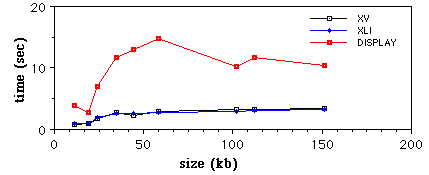
Fig.1: Workstation viewer comparison. Shown is a comparison of 3 Unix viewer applications opening a series of JPEG/JFIF images. The tests were run on a Hewlett Packard 50MHz workstation running in single user mode and the datapoints represent the average of 3 or more opening times for each image with each viewer. The standard error bars are too small to show.
Three viewers were compared for the Unix workstation, xv, xli, and ImageMagick display. The quality of the image was roughly comparable with all these viewers. For opening JPEG/JFIF files, xv and xli were significantly faster than ImageMagick for opening JPEG files (Fig 1). For opening GIF files, xv was somewhat faster than xli and ImageMagick (data not shown).
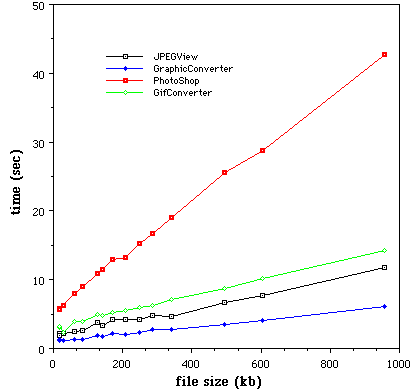
Fig. 2: Comparison of GIF Viewers on the Macintosh Platform. Four viewing programs are compared on a Macintosh 540c PowerBook regarding opening times of GIF images varying in size from 17 to 957 kilobytes (kb). Opening times in seconds were measured with a hand-held stopwatch. Each point represents three or more trials. Error bars are too small to show. Similar but faster times were obtained with the Macintosh 840AV (data not shown).
Four viewers were compared for the Macintosh platform, GraphicConverter, JPEGView, GIFConverter, and Adobe PhotoShop. The images generated by each of these programs appeared to be satisfactory. The fastest display was achieved by GraphicConverter, which typically opened GIF files in slightly more than half the time of the next closest viewer. Photoshop was significantly slower than the others.

Fig. 3: Comparison of Gif Viewers on the PC-Windows Platform. Four viewing programs are compared on a 486-66 PC regarding opening times of GIF images varying in size from 17 to 957 kb. Opening times in seconds were measured with a hand-held stopwatch. Each point represents three or more trials. Error bars are too small to show.
Four viewers were compared on the PC platform, Photostyler, LView Pro, and PaintShop, and WinJPEG. The images generated appeared to be adequate with each program. For JPEG/JFIF files, Photostyler, LView Pro, and Paint shop had comparable opening times, while WinJPEG was significantly slower. For GIF images, PaintShop and LView Pro were the most efficient.
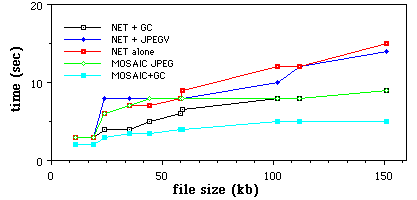
Fig. 4: Comparison of Viewer-Browser combinations on the Macintosh platform for viewing linked JPEG images. NCSA Mosaic 1.03 and Netscape 1.0 were compared with the viewers JPEGView and GraphicConverter, and Netscape set to open the test images were JPEG/JFIF files varying in size from 11 to 151 kb. Opening times were measured with hand-held stopwatch and the endpoint used was completed downloading and full image display. A minimum of three trials are represented by each datapoint. Error bars are too small to show.
The browsers, Netscape and Mosaic both performed well. Netscape has the advantage of being able to open in-line JPEG images. The speed tests gave mixed results with Mosaic being faster on the Macintosh platform and Netscape sometimes faster on the PC. On the Macintosh platform, the fastest opening times for JPEG/JFIF hypermedia images was with the combination of Mosaic and GraphicConverter. On the PC, Netscape as an external viewer proved the swiftest with JPEG images but Mosaic was up to 3 times faster for GIF images.
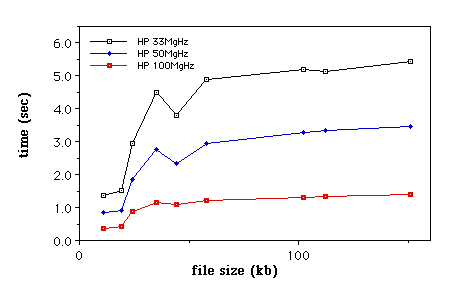
Fig. 5: Processor Comparison. Three Hewlett Packhard workstations, all running under HP-UX, were compared for processor time used to display JPEG/JFIF images varying in size from 11 to 151 kb. The viewing application used was xv, and the times were measured with the Unix time command. A minimum of three trials are represented by each datapoint. The error bars are too small to show.
The effect of processor speed on the time needed by viewing applications to display an image is demonstrated. For all platforms processor speed seemed to be important. The xv "processor time" for 100 MHz workstations to display JPEG images plateaued near 1 second compared to above 5 seconds for a 33 MHz workstation. On the Macintosh, stop-watch measurements of GraphicConverter image display time to open JPEG files reached a plateau under one second for 8100/80 as compared to 7 seconds for the Mac IIci. Similar tests on the PC platform using LView Pro gave opening times on the 586-90 of over 4 seconds as opposed to over 5 seconds for the 486-66. The time to open a 59 kilobyte image on the 386-40 was 24 seconds.
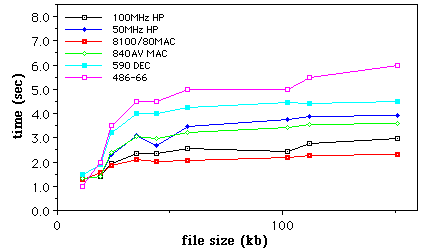
Fig. 6: Platform Comparison. Shown here are comparisons of the faster models from each platform regarding opening JPEG/JFIF images of varying sizes between 11 and 152 kb. The applications used for display are GraphicConverter, LView Pro (PC), and xv (Unix). A minimum of three trials are represented by each datapoint. The error bars are too small to show.
There was no common viewing software for cross-platform evaluation. Therefore the comparison made involved recording time from the initiation of the command to full image display, using the best software available at the time of the testing. Image opening times of the Macintosh 8100/80 running GraphicConverter were comparable to the fastest workstation tested.
 DISCUSSION
DISCUSSION
The choice of software for viewing WWW medical applications should be influenced by performance. The dermatology applications currently available are typically image-rich, and a delay in displaying these files can hinder their use. It has been said that for computing applications, a delay of greater than 5 seconds in response to a command is not well tolerated by the user.(4) Unfortunately delays of this size are now common for most people using WWW. Making these resources more usable therefore hinges in part on obtaining a faster connection and on using more efficient software and hardware. This evaluation which concentrates on the hardware and software issues, clearly demonstrates major time improvements are possible with some configuration variations.
The quality of the images appeared to be adequate for all of the viewers tested. There were, however, significant differences in the time required display images. For workstations running X-Windows, xv and xli were the best performers. Because xv has more image manipulation features, it was our first choice.
The variation in performance of viewers on the Macintosh platform was startling. Photoshop, an outstanding image manipulation program is noticeably slower than the other programs tested, and is not recommended as a simple viewer. JPEGView and Graphic Converter are excellent performers with many image manipulation features, but the speed of Graphic Converter made this our first choice.
Although the test results for the PC tended to be somewhat slower than Macintosh and workstations, a variation in performance among the viewers was also of note. The tested version of WinJPEG was slow enough to recommend avoidance. Paint Shop and LView Pro were the top runners. The tested version of Paint Shop was the fastest and would make the best simple viewer. LView Pro, although slightly slower had better image manipulation features and was only slightly slower.
Choosing the best browser may depend on the platform used and the format of the images. Netscape is an excellent browser which is capable of displaying linked images without using an associated viewer, but for the version we tested, configuring it with an external viewer was much faster. NCSA Mosaic is the standard, and the version we tested needed an associated viewing application in order to display linked images. For the versions we tested Mosaic was generally faster than Netscape, especially on the Macintosh. But the reader should note that these applications are rapidly being upgraded.
The processor has a significant effect on the time to open an image, independent of the software being used. Regardless of the platform being evaluated, performance was significantly enhanced by using a faster processor. The delays in image display with the slower units would make these impractical for WWW access.
 REFERENCES
REFERENCES
(2) Kelly B. Running a World-Wide Web Service. edition 1.1. SIMA Report Series. ISSN 1356-5370
(3) Lane T. jpeg-faq/part 2, rtfm.mit.edu/pub/usenet/news.answers/jpeg-faq. version 5 March, 1995.
(4) Boutell, Thomas. World Wide Web Frequently Asked Questions (FAQ), Part 2/2. 15 March, 1995.
All contents copyright (C), 1995. Dermatology Online Journal University of California Davis